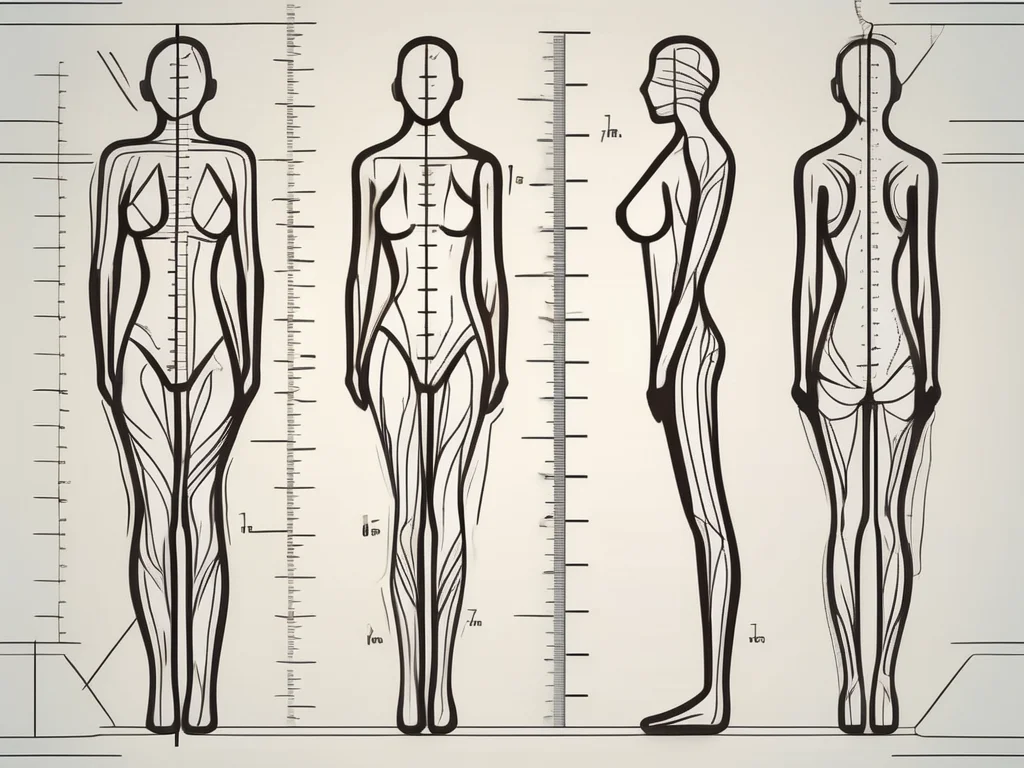The waist to height ratio (WHtR) is a simple yet powerful tool for evaluating your health. Unlike body mass index (BMI), which focuses on weight and height, WHtR zeroes in on abdominal fat distribution—a key indicator of health risks. This blog explores what WHtR is, how to calculate it, its importance, and practical steps to improve it for better health.
What Is Waist to Height Ratio?
Understanding WHtR
The waist to height ratio measures your waist circumference relative to your height. It’s calculated by dividing your waist measurement by your height, offering insight into body fat distribution, particularly visceral fat around the abdomen. A higher ratio signals a greater risk of health issues like heart disease or diabetes.
Why WHtR Matters
WHtR is a more precise health indicator than BMI because it focuses on abdominal fat, which is metabolically active and linked to serious conditions like cardiovascular disease, type 2 diabetes, and metabolic syndrome. Monitoring WHtR helps you track body composition changes and take proactive steps to reduce health risks.
Why Is Waist to Height Ratio Important?
Health Risks of Excess Abdominal Fat
Excess visceral fat, indicated by a high WHtR, can lead to inflammation, insulin resistance, and chronic diseases. Unlike subcutaneous fat, visceral fat surrounds vital organs, making it particularly harmful. A healthy WHtR reduces your risk of these conditions and supports long-term well-being.
Tracking Progress Over Time
Regularly measuring your WHtR allows you to monitor reductions in abdominal fat and assess improvements in your health. It’s an empowering tool for making informed lifestyle and dietary choices to prevent obesity-related diseases.
How to Calculate Your Waist to Height Ratio
Tools You Need
To calculate your WHtR, you’ll need:
- A flexible tape measure for waist circumference.
- A reliable height measurement tool, like a stadiometer or wall-mounted board.
Step-by-Step Calculation
Follow these steps for an accurate WHtR:
- Stand upright with feet together and weight evenly distributed.
- Find the narrowest part of your waist, typically near the navel.
- Wrap the tape measure around your waist, ensuring it’s snug but not tight, and parallel to the floor.
- Record your waist measurement (in inches or centimeters).
- Measure your height accurately and note it (in inches or centimeters).
- Divide your waist measurement by your height.
- Round the result to two decimal places to get your WHtR.
Example: If your waist is 32 inches and your height is 66 inches, divide 32 by 66 to get 0.48.
What Does Your Waist to Height Ratio Mean?
Interpreting Your Results
Your WHtR indicates your health risk level:
- Below 0.5: Healthy – Low risk of chronic diseases.
- 0.5 to 0.6: Moderate Risk – Some risk of health issues; consider lifestyle changes.
- Above 0.6: High Risk – Significant risk of obesity-related diseases; take action to reduce abdominal fat.
WHtR Chart for Men and Women
| Waist to Height Ratio | Category |
|---|---|
| Below 0.5 | Healthy |
| 0.5 – 0.6 | Moderate Risk |
| Above 0.6 | High Risk |
A lower WHtR correlates with better health outcomes, so aim to keep it below 0.5.
How to Improve Your Waist to Height Ratio
Lifestyle Changes for a Healthier WHtR
Reducing your WHtR involves adopting sustainable habits:
- Healthy Diet: Focus on whole foods like fruits, vegetables, lean proteins, and healthy fats. Avoid processed foods, sugary drinks, and excessive saturated fats.
- Regular Exercise: Incorporate both cardio and strength training to burn fat and build muscle.
- Stress Management: High stress can increase abdominal fat; practice mindfulness or yoga.
- Adequate Sleep: Poor sleep disrupts metabolism, so aim for 7-8 hours nightly.
- Limit Alcohol and Smoking: Both can contribute to fat accumulation and poor health.
Exercise Tips
- Cardio: Activities like jogging, cycling, or swimming burn calories and reduce body fat. Aim for 150 minutes of moderate cardio per week.
- Strength Training: Weightlifting or bodyweight exercises (e.g., planks, squats) boost metabolism and improve body composition. Train 2-3 times weekly.
- Core Workouts: Target abdominal muscles with exercises like crunches or leg raises to tone the waist area.
Diet Tips
- Eat balanced meals with plenty of fiber-rich vegetables and whole grains.
- Choose water or unsweetened teas over sugary beverages.
- Control portion sizes and practice mindful eating to avoid overeating.
- Limit fast food, fried foods, and high-sugar snacks.
Why WHtR Outperforms BMI
Limitations of BMI
BMI uses only weight and height, ignoring fat distribution. Two people with the same BMI can have vastly different health risks depending on where their fat is stored. WHtR provides a clearer picture by focusing on abdominal fat, a stronger predictor of health issues.
Scientific Backing
Studies show WHtR is a better indicator of risks for heart disease, diabetes, and metabolic syndrome. Its simplicity and focus on visceral fat make it a practical tool for health assessments.
Common Questions About Waist to Height Ratio
People Also Ask
- Is waist to height ratio accurate for everyone?
WHtR is a reliable indicator for most adults but may be less accurate for children, pregnant women, or individuals with unique body compositions (e.g., athletes with high muscle mass). Consult a healthcare provider for personalized advice. - How often should I measure my WHtR?
Measure every 1-2 months to track progress, especially if you’re making lifestyle changes. Avoid daily measurements, as small fluctuations are normal. - Can WHtR predict heart disease?
Yes, a high WHtR is strongly linked to cardiovascular risks due to visceral fat’s impact on inflammation and insulin resistance. Keeping your ratio below 0.5 lowers this risk. - What’s a healthy waist size for my height?
Your waist should ideally be less than half your height. For example, if you’re 70 inches tall, aim for a waist circumference below 35 inches.
Practical Tips for Long-Term Success
Set Realistic Goals
Aim for gradual improvements in your WHtR rather than drastic changes. A sustainable approach to diet and exercise yields lasting results.
Stay Consistent
Consistency in healthy eating and regular physical activity is key to reducing abdominal fat and maintaining a healthy WHtR.
Monitor Progress
Track your WHtR over time to stay motivated. Use a journal or app to log measurements and celebrate small wins.
Seek Professional Guidance
If your WHtR is in the high-risk category, consult a doctor or dietitian for tailored advice on reducing health risks.
Conclusion
The waist to height ratio is a valuable, easy-to-use tool for assessing health risks associated with abdominal fat. By calculating and interpreting your WHtR, you gain insights into your body composition and potential health risks. Adopting a healthy diet, regular exercise, and positive lifestyle changes can help you achieve and maintain a healthy WHtR, reducing your risk of chronic diseases like heart disease and diabetes. Start measuring your WHtR today and take control of your health for a better, longer life.
FAQs: Using Waist-to-Height Ratio as a Health Indicator
What is waist-to-height ratio (WHtR)?
The waist-to-height ratio is a simple measurement that compares your waist circumference to your height. It helps assess abdominal fat and related health risks, such as heart disease, diabetes, and metabolic syndrome.
How do I calculate my waist-to-height ratio?
Measure your waist circumference at the narrowest point (or just above the navel) and divide it by your height (both in the same units, e.g., cm or inches).
Formula: WHtR = Waist ÷ Height
What is a healthy waist-to-height ratio?
A WHtR of 0.5 or less is generally considered healthy for both men and women. Ratios above 0.5 may indicate higher risk of obesity-related health problems.
Why is waist-to-height ratio better than BMI?
Unlike BMI, which only considers weight and height, WHtR focuses on abdominal fat, which is a stronger predictor of heart disease, diabetes, and metabolic risks.
Can waist-to-height ratio help with diabetes risk assessment?
Yes, higher abdominal fat increases insulin resistance and the risk of Type 2 diabetes. Monitoring WHtR can help identify risks early and guide lifestyle changes.



